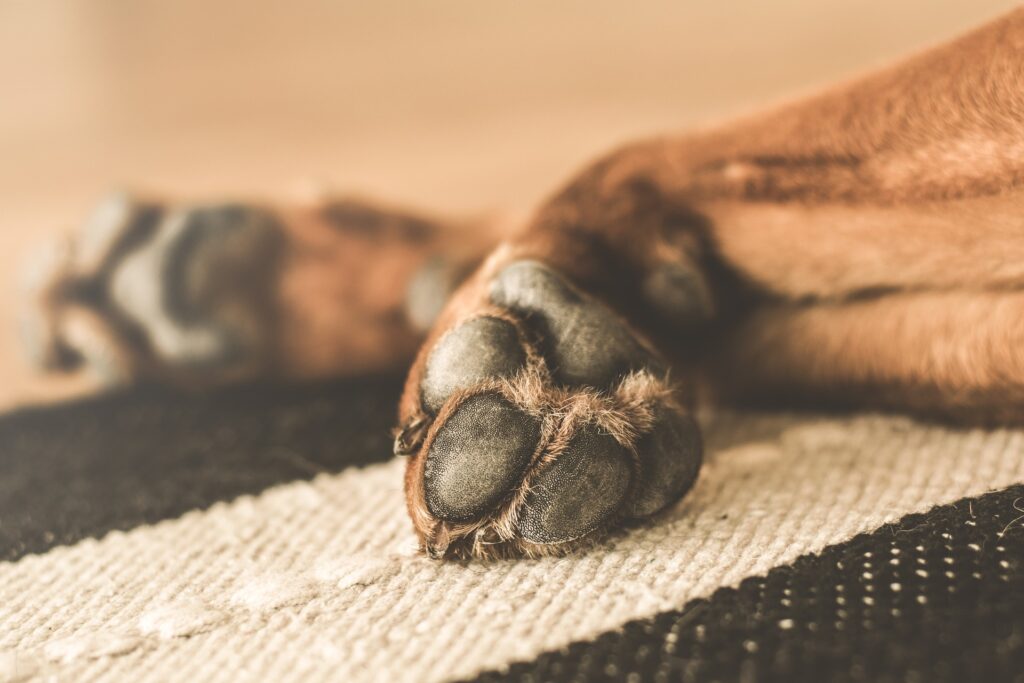The Library
Does puppies’ bedding affect risk of hip dysplasia?
A review of
Feng, L. C., Philippine, A., Ball-Conley, E., & Byosiere, S. E. (2025). Fleece-Lined Whelping Pools Associated with Reduced Incidence of Canine Hip Dysplasia in a Guide Dog Program. Animals, 15(2), 152. https://doi.org/10.3390/ani15020152
By Jessica Dawson
Introduction
Canine hip dysplasia (CHD) is a common orthopaedic condition that can be painful for dogs and costly both economically and emotionally for owners. While the heritability of CHD is well-established, previous research also indicates that a dog’s early experiences, such as stair usage and off-leash play in the first three months of life, can significantly influence their likelihood of developing the condition. However, studies on the impact of early exposure to different types of flooring have yielded mixed results. One study found no effect, while another suggested that puppies raised on slippery floors were more likely to develop clinical signs of CHD. This study aimed to further investigate the impact of flooring on the development of CHD through examining whether changing the flooring in the whelping location during the first three weeks of life from slippery newspaper to non-slip fleece impacted the rate of CHD diagnoses in a large population of guide dog candidates.
Method
The study retrospectively analysed historical dog records from Guide Dogs For the Blind, a non-profit guide dog school, to compare two groups: those who whelped and reared their litters for the first three weeks on non-slip veterinary fleece (STERI-LON), and those who whelped and reared their litters for the first three weeks on newspaper. Rates of CHD were examined through radiographs and PennHIP scores. Historical records of 5649 dogs (Labrador Retrievers, Golden Retrievers, and Labrador-Golden Retriever crosses; 51.53% male) who were raised between mid-2012 and the end of 2019 were included in this study.
All puppies were initially raised in plastic clamshell pools before moving to epoxy flooring at around 3 weeks of age. Puppies born after March 2016 (2864 puppies) had fleece-lined clamshell pools, while those born before December 2015 (2784 puppies) had newspaper-lined pools and served as the control group. At 6 weeks, all puppies had a veterinary exam before being sent to volunteer raising families at about 9 weeks of age. Any puppies showing signs of orthopaedic issues while with their volunteer family were examined by a local veterinarian, and further testing, including radiographs, was conducted if deemed clinically necessary. At around 16 months, dogs deemed suitable were returned to one of the organization’s campuses for further evaluation as potential guide or breeding dogs. At this point, all dogs being considered underwent hip radiographs, and those being considered for breeding also had PennHIP testing.
Results
The total incidence rate of CHD in the sample was 1.13% (64 dogs). 70.76% of the dogs received hip radiographs and 7.59% received both radiographs and PennHIP scoring.
All statistical analyses which were conducted accounted for the relatedness amongst the dogs included in the sample. Results indicated that Golden Retrievers had the highest risk of CHD diagnosis and the highest PennHIP scores, with Labradors having the lowest risk of CHD and the most favourable PennHIP scores, with the Labrador–Golden Retriever crosses sitting in the middle. No differences between males and females were noted. The heritability of CHD in the sample was 0.237, suggesting a low-moderate heritability rate. A correlation between whelping pool substrate and risk of CHD was found, with dogs who were raised in the fleece-lined pools for the first 3 weeks of their life having a lower risk of CHD diagnosis than those raised on newspaper, though the PennHIP scores remained similar in both groups. Of the dogs diagnosed with CHD, 84.38% were whelped on newspaper.

Discussion
The results of this study indicate that puppies raised on flooring with more traction in the neonatal period had a decreased risk of developing CHD than those raised on flooring with less traction. This risk varied by breed, with Golden Retrievers having the highest incidence Labradors having the lowest. Interestingly, no statistically significant difference was found in PennHIP scores between dogs reared on fleece and those reared on newspaper. However, this similarity may be due to sampling bias, as only a small subset of dogs considered for breeding received PennHIP scoring after their hip radiographs were completed. These results suggest that environmental factors, such as the type of flooring puppies are reared on during the neonatal period, may play a role in the development of orthopaedic disease like CHD.
This study had several features that we need to keep in mind when interpreting the findings. Whilst the sample size in this study was commendably large, it is important to note that the overall incidence of hip dysplasia was lower than that of the wider population, though the heritability rate (low to moderate) was consistent with what has been published previously. Additionally, radiographic screening was not available for all dogs included as some were rehomed prior to entering training at 16 months. This means that the overall incidence rate of CHD may have been underestimated in the sample, though they were monitored during the rearing process for any symptomology. It is also possible that the findings of decreased incidence of CHD are a result of selective breeding pressures rather than the change in substrate. However, the data showed a marked drop when the change was made to fleece, rather than a steady decline in incidence that you would expect if breeding was the cause. This points to factors at play beyond selective pressures and points to an environmental cause, such as the move to a whelping substrate with more traction.
These results are an important first step in understanding the role that early environment plays in the development of one of the most common orthopaedic diagnoses impacting dogs today. Though these results are correlational in nature (not causative), they represent one of the first and largest investigations into how the substrate on which puppies are reared may play an important role in their orthopaedic health in adulthood. Hopefully, future studies will focus on expanding on these findings by examining the impact of other types of flooring over a wider age range and in a larger variety of breeds.
Summary
Canine hip dysplasia is a condition that is often a primary concern for both breeders and owners and is believed to have both polygenic and environmental components. While many breeders work diligently to reduce the risk of CHD in their breeding lines by conducting orthopaedic testing like those used in this study and excluding dogs with unfavourable results, many also seek tangible changes they can implement in their rearing practices. The findings presented in this study may offer valuable insights for breeders of all breeds when making decisions about how to raise their litters in a way that minimizes the risk of orthopaedic issues like CHD. One simple yet effective strategy could be altering the material on which puppies are reared during their first few weeks of life, potentially reducing the likelihood of developing CHD.


